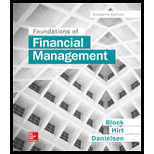
a.
To calculate: The value offered per share of Chicago Savings Corp.
Introduction:
Share Price:
The highest price of one share of a company that an investor is willing to pay is termed as the share price. It is current price used for the trading of such a share.
b.
To calculate: The percentage gain at the computed price in part (a) for Chicago Savings Corp.
Introduction:
A rate that shows the net profit or loss, an investor earns or loses on the investment over a particular time period is termed as the rate of return.
Percentage Gain:
It is the percentage that shows the net gain, an individual gain at the time of selling a product and it can be calculated by dividing the difference of the cost price and selling price from the original price (cost price). It is incurred when a product is sold at more than its cost price.
c.
To calculate: The percentage loss value after the cancellation of merger for Chicago Savings Corp.
Introduction:
Rate of return:
A rate that shows the net profit or loss that an investor earns or loses on the investment over a particular time period is termed as the rate of return.
Percentage Loss:
It is the percentage that shows the net loss that an individual loses at the time of selling a product and it can be calculated by dividing the difference of the cost price and selling price from the original price (cost price). It is incurred when a product is sold at less than its cost price.
d.
To calculate: The expected value of the return on Chicago Savings Corp.’s investment.
Introduction:
Expected value:
Also known as the mean, it is the value that is estimated or anticipated to be earned in the future from an investment. It is computed by adding up the values that are the result of multiplying each outcome from the probability.
Want to see the full answer?
Check out a sample textbook solution
- AP Associates needs to raise $35 million. The investment banking firm of Squeaks, Emmie, andChippy will handle the transaction.a. If stock is used, 1,800,000 shares will be sold to the public at $21.30 per share. The corporation willreceive a net price of $20 per share. What is the percentage underwriting spread per share?b. If bonds are utilized, slightly over 37,500 bonds will be sold to the public at $1,000 per bond. Thecorporation will receive a net price of $980 per bond. What is the percentage of underwritingspread per bond? (Relate the dollar spread to the public price.)c. Which alternative has the larger percentage of spread?arrow_forwardGracie’s Dog Vests currently has 5,200,000 shares of stock outstanding and will report earnings of$8.8 million in the current year. The company is considering the issuance of 1,500,000 additionalshares that will net $28 per share to the corporation.a. What is the immediate dilution potential for this new stock issue?b. Assume that Grace’s Dog Vests can earn 8 percent on the proceeds of the stock issue in time toinclude them in the current year’s results. Calculate earnings per share. Should the new issuebe undertaken based on earnings per share?arrow_forwardYou plan to contribute seven payments of $2,000 a year, with the first payment made today (beginning of year 0) and the final payment made at the beginning of year 6, earning 11% annually. How much will you have after 6 years? a. $12,000 b.$21,718 c.$19,567 d.$3,741arrow_forward
 Intermediate Financial Management (MindTap Course...FinanceISBN:9781337395083Author:Eugene F. Brigham, Phillip R. DavesPublisher:Cengage Learning
Intermediate Financial Management (MindTap Course...FinanceISBN:9781337395083Author:Eugene F. Brigham, Phillip R. DavesPublisher:Cengage Learning
